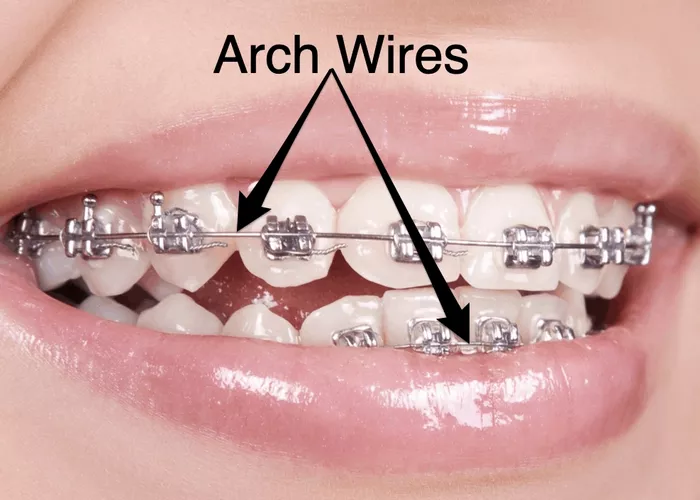Braces are a popular solution for correcting misaligned teeth and improving the overall appearance of a person’s smile. One crucial component of braces is the archwire. Although often overlooked, archwires play an essential role in orthodontic treatment by guiding the teeth into their correct positions. In this article, we will explore what archwires are, their functions, different types, and how they contribute to the overall effectiveness of braces.
What is the Role of Archwires in Braces?
Archwires are thin metal wires that are a fundamental part of the braces system. They are positioned across the brackets that are attached to the teeth, forming a “arch” shape. These wires are adjusted regularly during orthodontic appointments to apply gentle, consistent pressure to the teeth, helping them shift into proper alignment.
While the brackets attached to the teeth hold the archwire in place, it is the archwire that delivers the force necessary to move the teeth. The combination of the archwire and brackets helps guide the teeth through the different stages of treatment until the desired alignment is achieved.
How Archwires Work in Braces
The function of the archwire goes beyond merely connecting the brackets. Archwires are designed to provide continuous pressure, which is essential for effective braces treatment. This pressure gradually shifts the teeth into the correct positions over time, allowing for gradual improvements in alignment. Archwires can be adjusted by the orthodontist depending on the specific needs of the patient and the progress of the treatment.
When the archwire is first inserted, it is generally straight, and over time, it is adjusted to a shape that encourages the teeth to move towards their correct alignment. Archwires are designed to be flexible, meaning that they can be bent or adjusted in a variety of ways to ensure that they fit the specific needs of the patient’s orthodontic treatment.
Types of Archwires
There are several different types of archwires used in orthodontics, each with unique characteristics. The choice of archwire depends on the stage of treatment, the type of braces, and the goals of the treatment. Below are some of the most common types of archwires:
1. Stainless Steel Archwires
Stainless steel archwires are the most commonly used in braces. Known for their durability and strength, these wires are used throughout the majority of orthodontic treatments. They provide excellent control and are capable of exerting the necessary pressure to move teeth efficiently. Stainless steel archwires are often chosen for their resistance to corrosion and wear, making them an ideal choice for long-term use.
2. Nickel-Titanium Archwires
Nickel-titanium archwires are typically used during the initial stages of orthodontic treatment. These wires are known for their ability to “remember” their shape. This characteristic allows the wire to exert a continuous, gentle force on the teeth, making them ideal for patients who require less force for their teeth to move. Nickel-titanium archwires are flexible and can be adjusted to fit the specific needs of the patient.
3. Beta-Titanium Archwires
Beta-titanium archwires combine the flexibility of nickel-titanium with the strength and durability of stainless steel. These wires are often used in the later stages of treatment, where more force is required to finalize tooth positioning. Beta-titanium archwires are commonly chosen for their ability to provide more precise control while still maintaining a relatively gentle force.
4. Copper-Nickel-Titanium Archwires
Similar to nickel-titanium archwires, copper-nickel-titanium archwires offer greater flexibility and can provide a smoother transition between stages of treatment. The copper element enhances the wire’s ability to provide consistent pressure throughout the treatment process, making them useful for moving teeth more effectively.
Adjusting Archwires in Braces
Throughout the course of orthodontic treatment, the archwires are regularly adjusted to ensure that the teeth continue to move in the desired direction. These adjustments are typically made during routine appointments with the orthodontist, which are scheduled every 4 to 6 weeks. During these visits, the orthodontist will replace or adjust the archwires to ensure that they are applying the right amount of pressure to guide the teeth into their final position.
How Archwires Contribute to Braces Types and Braces Cost
While archwires are an essential component of any braces system, their specific design can influence the overall treatment process. Some braces types, such as self-ligating braces, incorporate a more advanced mechanism for holding the archwire in place, reducing the number of adjustments needed. The choice of archwire material and design can also affect the braces cost as more advanced materials tend to be more expensive.
Archwires and Braces Colors
For patients looking to add a personal touch to their orthodontic treatment, the braces colors are an important consideration. While the archwires themselves are typically silver or metallic, they can be paired with colorful elastics that are attached to the brackets. These elastics come in a wide range of colors, allowing patients to customize their appearance during treatment. Though the archwire’s function remains the same, the colorful elastics can provide an aesthetic element to the process.
Conclusion
In summary, archwires are an essential part of braces, working to move teeth into their correct positions by applying constant pressure. With various materials available, each offering unique benefits, orthodontists carefully select the right archwire for each patient’s treatment. Whether it’s a stainless steel wire for durability or a nickel-titanium wire for flexibility, the archwire plays a vital role in creating a beautiful, aligned smile. The archwire, together with other components like brackets and elastics, ensures the overall success of braces treatment and helps patients achieve their desired results.
Related topics

